#simone le bargy
Text

Henry Caro-Delvaille - Portrait de Madame Simone (1908)
108 notes
·
View notes
Text
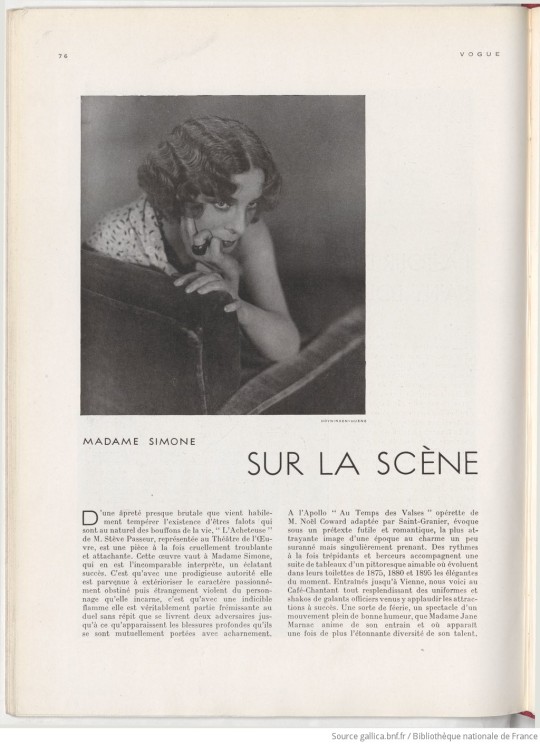
Actress Madame Simone in the June 1930 French Vogue, photograph by George Hoyningen-Huene.
(source: Gallica)
#madame simone#simone le bargy#pauline benda#1930s actress#french film#1930s fashion#french vogue#george hoyningen huene#photography
3 notes
·
View notes
Photo
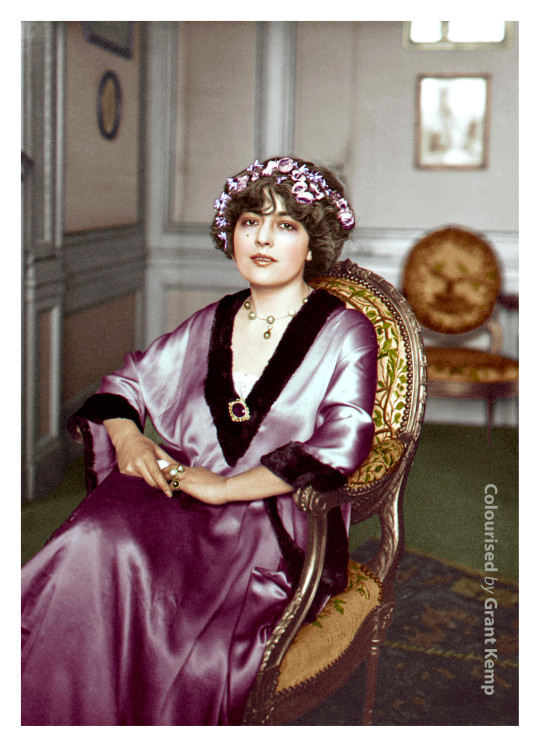
'Tragic accident' or murder? The short life of the most photographed woman on the Paris stage, 1910 ....
Geneviève "Ginette" Lantelme (born Mathilde Hortense Claire Fossey, May 20, 1883 was a French stage actress, socialite, fashion icon, and courtesan. Considered by her contemporaries to be one of the most beautiful women of the Belle Epoque and bearing a resemblance to American actress Ethel Barrymore, she is remembered for the mysterious circumstances of her death: on the night of July 24/25, 1911, she fell from the yacht of her husband, Alfred Edwards. Mathilde was the third child of Edouard Fossey, a cashier who later became an accountant, and his wife Claire (maiden name Lantelme). Born in Paris, Mathilde had two older sisters and one younger one. In 1895, Mathilde’s parents divorced, and the court gave custody of the children to Edouard. Another French actress of the turn of the century, Simone le Bargy, wrote about Lantelme in her memoirs, Sous de nouveaux soleils, in which she claimed, among other things, that Mathilde somehow ended up in a brothel run by her mother at the age of fourteen. Said to be one of the most prized lures at her mother's brothel, Mathilde sought fame, and soon became an acclaimed Paris actress. Theatregoers savoured her reputation for enjoying the bodies of men and women with equal pleasure: her languid slouch was imitated by other Parisian vamps. What is certain is that as a teenager, Mathilde found protection in powerful men, including Henry Poidatz, banker and owner of Le Matin newspaper, whose mistress she became in her late teens. On April 1, 1905, Lantelme opened in a play called L’Age d’Aimer, whose leading role was played by the legendary actress Réjane. Upon hearing that her friend Alfred Edwards, a media tycoon and amateur playwright, had written a play named Par Ricochet and was looking for an actress, Réjane introduced him to Lantelme, who soon became his mistress. During her short career in the limelight, Lantelme was photographed often and featured in newspapers and magazines in both Europe and the United States. From 1906 to 1909, Lantelme shared Edwards’ attentions with his fourth wife, Misia Sert. Misia was extremely jealous of her husband's mistress, and said in her memoirs "I had contrived to get a photograph of Lantelme; it adorned my dressing-table, and I made desperate efforts to look like her, dress my hair in the same way, wear the same clothes." Eventually the younger woman won the battle for Edwards’ affections, and on July 5, 1909, Lantelme and Edwards married in Rouen, France. In early July 1911, Lantelme, her husband Edwards, and a few of their friends boarded Edwards’ yacht, L’Aimée. On the night of July 24/25, Lantelme disappeared, and a few days later her body was discovered in the waters of the Rhine River. The official verdict was that the young actress had drowned as the result of a tragic accident. However, many people speculated that Edwards had murdered his wife. In the autumn of 1911, two French newspapers, La Depéche Parlementaire and La Griffe, published their accusation that Edwards had murdered Lantelme; Edwards sued the publications for libel and won, although both newspapers escaped severe punishment. Buried in Pere Lachaise cemetery in Paris, rumors of her jewels being buried with her led to thieves ransacking the crypt. They found nothing. Some of the jewels were rumored to have been given to Edwards’ new flame, actress Colonna Romano, who shortly before his death became Edwards’ sixth and final wife. Edwards died in 1914 and was buried with Genevieve, so her family made sure Genevieve was moved to the Fossey family tomb in another part of the cemetery. This is my colourised version of a black & white portrait taken around 1910
Restoring Your Past … Website
Restoring Your Past … on Facebook
#belle epoque#Victorian#murder#French#stage#actress#socialite#fashion icon#courtesan#vintage#history#colourised#colorized#Photo Colourisation#photo colorization
9 notes
·
View notes
Text
Who wore it best?
Various actors dressed for Chantecler, a play written by Edmond Rostand and set in a barnyard.
Lucien Guitry, 1910:


Gertrude Hoffmann, 1910:

Simone le Bargy, 1910:
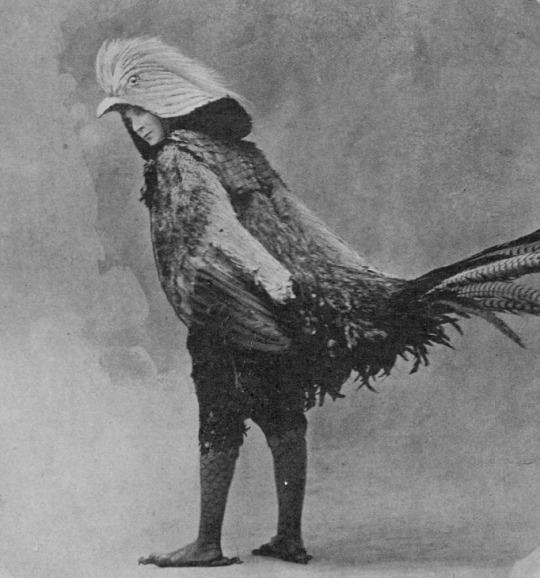
Maud Jay, Frances Kapstowne and Davy Burnaby, 1910:
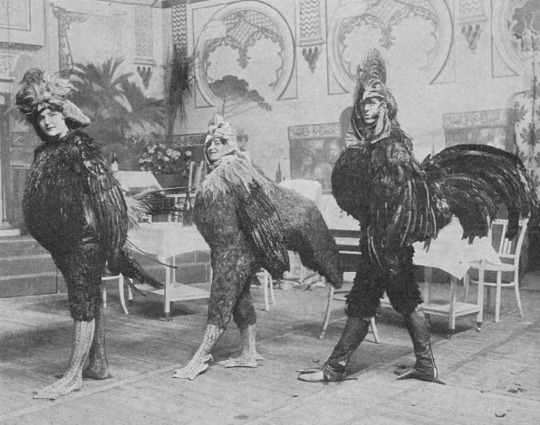
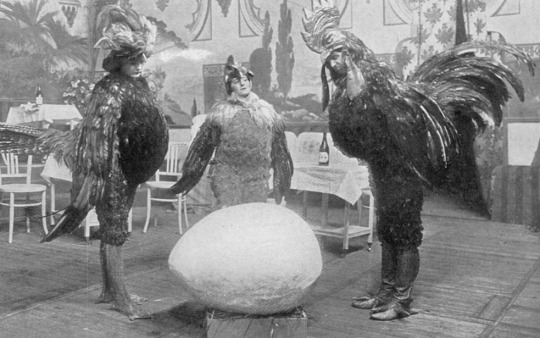
Maude Adams, 1911:
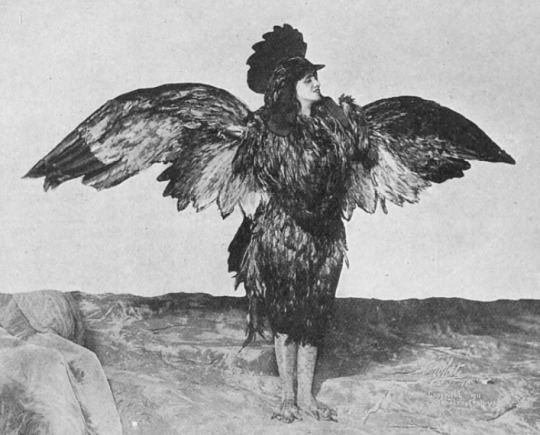
Bonus contestant! although most characters were feathered, the play did feature other animals, like this dog:
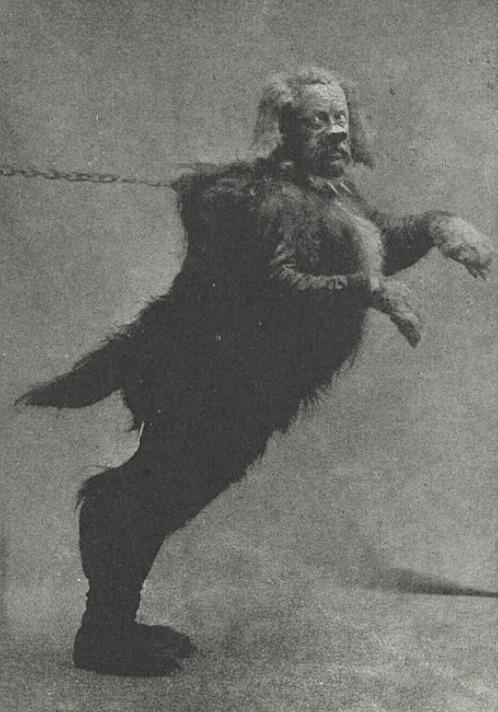
And these frogs (I wish I had a clearer photo):

#chantecler#1910s#edwardian era#edwardian#theatre#plays#dogs#chickens#animals#costume#edmond rostand
6K notes
·
View notes
Quote
20 août 1914
Ma bien-aimée,
Je t’aime. Je suis à toi
pour éternellement, ton Henri.
Mon amour, j’ai pris pour la première fois la capote ce soir. Je suis furieux. J’ai l’air d’un collégien à qui on ne permet pas de porter les cheveux longs. Il y a une vieille femme qui me poursuivait ce soir pour me dire : Vous avez beau être jeune,vous savez bien les commander. Car je commande toujours, tu sais, avec ma voix et ma figure dures que tu n’aimes pas, mon amour, mon ange, mon petit, ma femme, ma Pauline, ma beauté chérie, mon adoration. […]
Je te supplie, je te supplie de faire faire ton portrait, si cela est possible, par n’importe qui, par une marchand de cartes à cinq sous s’il en reste encore. Mais je te supplie de me donner ce bonheur. Pense qu’il y a eu des portraits de toi dans des centaines de revues et que je n’ai même pas sur un de ces bouts de pages coupé avec des ciseaux cette figure d’ange auprès de laquelle il n’y a pas de beauté, cette figure que j’ai embrassée, baisée, serrée dans mes mains, battue, secouée, caressée, adorée, possédée.
Je suis fatigué. Je suis à la caserne et non pas à la guerre. Je ne vois plus rien qui ait le goût de la guerre.J’ai un capitaine vachard,baderne et ennuyeux à pleurer.Il me semble auprès de lui que j’ai quinze ans de service et que je suis fatigué du métier. […]
Chérie, ma fille, ma beauté, ma fiancé, mon amour, quand je n’en puis plus de regrets, de peine de ne plus t’avoir, je relis tes lettres. Je retrouve dans ces pages bleues toute la confiance ,toute l’ardeur qu’il faut. J’ai peur que ce que tu as vu à Auch (les discours ratés, la présentation au drapeau mal organisée, les hommes qui rigolent, cet atmosphère de caserne) je t’ai enlevé cette flamme, cet esprit de sacrifice, ce désir sacré de la victoire. Amour, il faut que tu ne cesses pas de croire ardemment à ce que nous faisons. Songe que nous marchons dès avant l’aube, que nous marchons des jours entiers sans savoir où nous allons, que nous attendions dans des cours de ferme des heures et des heures sans savoir pourquoi, songe à toute la patience, à toute la religion qu’il nous faut pour résister à ce chagrin d’avoir perdu ce que l’on aime. Songe que nous serons peut-être bientôt couchés dans des tranchées dans l’eau et le froid et la boue, sous le feu. Il ne faut rien nous dire, il ne faut rien penser qui nous enlève un peu de foi et nous coupe les jambes. C’est de toi que j’attends toute ma force, toute ma vertu, toute mon audace, tout mon mépris de la mort.
[…]Ton enfant,
Henri
Henri-Alban Fournier, dit «Alain Fournier» allait avoir vingt huit ans lorsqu’il écrivait ces lignes à Pauline Le Bargy plus connue sous le nom de Mme Simone. Pauline fut le dernier amour de Fournier : il aurait dû l’épouser au terme de la guerre. Mais Fournier voulait d’abord faire tout son devoir. Il sera tué le 18 septembre 1914 dans le petit bois de Saint-Rémi-la-Calonne.
10 notes
·
View notes
Text
Ginette Lantelme

Okay most of this is coming from Wikipedia, but this is highly amateur. But I’m trying to make it nice and easy to read so it’s not exactly that. But please note you can probably get all of this post from the Free Encyclopedia. But I have commentary, so that’s fun-nish, right? And the internet’s mostly a void anyway. But, if you read this, don’t write a paper using this as a source. Unless it’s about my attempt at humor, or plagiarism (which I am trying not to do, but also this isn’t in any way money related or academic, so I don’t think it counts. But please go to the Wikipedia page and donate or whatever just in case?). Really, this is a paraphrasing + an attempt at comedic commentary about something that probably isn’t actually appropriate to joke about.
Geneviève “Ginette” Lantelme (nee Mathilde Hortense Claire Fossey)
actress, socialite, fashion icon, courtesan
1883-1911
So Ginette Lantelme seems like a character in some ways. She is born Mathilde Hortense Claire Fossey, which is both such an elegant name and so clunky and old fashioned sounding. She is also born in 1883 in Paris, which sounds both terrible and lovely– maybe darkly glamorous? And then her life seems like if the musical Gigi just got super dark (I don’t know a ton of courtesan movies).
So apparently she maybe (according to Simone le Bargy) wound up at 14 years old working in her mother’s brothel (take your daughter to work day?). Then she became Henry Poidatz’s mistress. He had a pointy beard and nicely groomed eyebrows, according to the photo Wikipedia decided best showed him (see below).

So then Mathilde thought “I have a fancy rich boyfriend, and I want to get into movies, so I’ll do that.” Except I guess she decided Mathilde Fossey sounded weird, so she took her mother’s maiden entire name, Genevieve Lantelme, because clearly her mother, who pimped out her 14-year-old daughter, was a good role model.
So Genevieve does a few small parts, and then gets into the Paris Conservatory to study what I, with my talent with cognates, believe to be French Comedy (Comédie Francais). And she’s not allowed to work while a student, but is a super rebel and breaks the rules and acts under the stage name “Telmy.” (I looked up Telmy but found it was an Australian market research system and a cell phone plan? So she probably didn’t pick the name from that. It kind of sounds like Mathilde except if you take out a lot of letters and add a y? Clearly I don’t know).
Side note: then Wikipedia has jut a hilarious sentence– “Lantelme completed her course of study without receiving any prizes or distinctions, as her comedic talent was not valued by her school or her teachers.” It is reminds me of what the movie Legally Blonde says about Warner at the end (about him not having any job offers and graduating without honors). It just basically says “she graduated, but no one thought she was any good.”
But Genevieve did other plays, and met Gabrielle Réjane, who was a fancy shmancy actress. And Réjane heard that her friend, Alfred Edwards, needed a lead for his show, and recommended Genevieve. Still being Mathilde Fossey, she becomes Edwards’s mistress (somewhere she must have ditched Poidatz). Wikipedia’s picture of Edwards shows that Geneviéve must have had a thing for polished facial hair.

She acts some more, gets sued, loses, has to pay Réjane a lot of money, and finally starts getting popular. She’s on magazines and has various fashion things happen, which is fun.
Side note: Edward’s wife (fourth wife! and he still needs a mistress!) starts getting jealous. (Side note to side note: apparently she was a pianist and patron of the arts, Misia Sert. Also, Edwards was Sert’s second husband, also out of several. Because turn of the century France). So Misia Sert puts Genevieve’s picture on her dressing table and tries to copy her, which just seems so sad. And then, as if that wasn’t enough, Marcelle Proust based some stuff in In Search of Lost Time on Misia’s jealousy. There’s also a story (in usan Griffin’s The Book of the Courtesans: A Catalogue of their Virtues (2001), as reported by https://bizarrevictoria.wordpress.com/2017/03/17/genevieve-lantelme/) that basically boils down to Genevieve telling Misia she could have Edwards back for the price of “ pearl necklace you’re wearing, one million francs – and you.” Like, what?? Not only is she a courtesan, actress, and socialite, and fashion icon, but also a conniving lesbian?? What could be more glamorous?
And then Edwards divorces Misia Sert and marries Genevieve. But then, two years later, Genevieve goes missing after a yachting trip. And then she is found in the Rhine. It was officially an accident, but was it Edwards murdering a wife??? Two newspapers said so, but then Edwards sued and won, so who knows? Either Edwards was a murderer who not only got away with it but got a payout, or he was a grieving widower who then had to deal with people saying that he killed his wife. According to the way-to-much amount of crime dramas I watch, he was the likely person, because the first suspect is always the spouse, but modern technology would have shown at the last minute that it was actually someone who wasn’t even on the boat! But actually, death is a sad thing, especially a tragic one that happened too early in her life. Whether an accident or a murder, Lantelme somehow drowned at 28 years old, which is really young and sad.
Where are the rest of the characters in this story now? Well, they are all dead now too, because, you know, this happened a long time ago. For more specific information, look at links below, or ask for another post.
The End
site: https://en.wikipedia.org/wiki/Genevi%C3%A8ve_Lantelme
https://fr.wikipedia.org/wiki/Henry_Poidatz#/media/File:Poidatz,_Henry.jpg
https://en.wikipedia.org/wiki/Misia_Sert
https://en.wikipedia.org/wiki/Alfred_Edwards_(journalist)
https://en.wikipedia.org/wiki/Gabrielle_R%C3%A9jane
https://en.wikipedia.org/wiki/In_Search_of_Lost_Time
0 notes